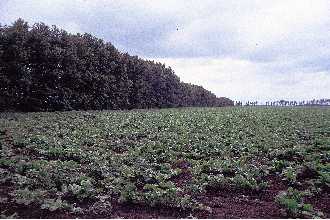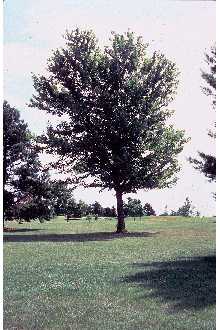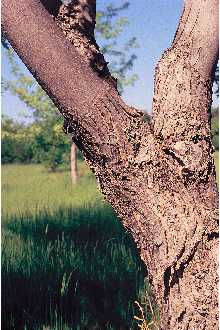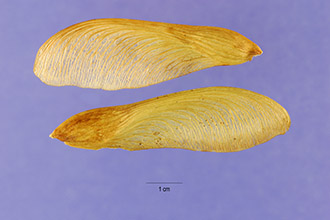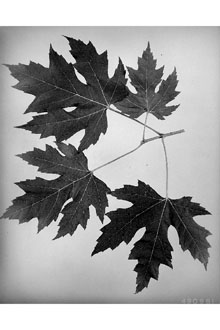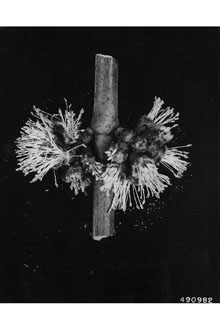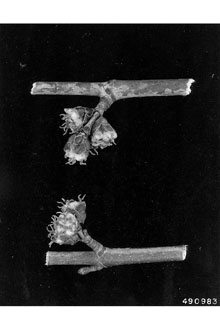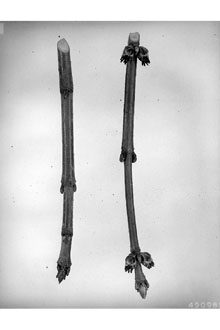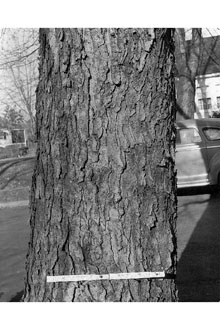Silver Maple
Scientific Name: Acer saccharinum L.
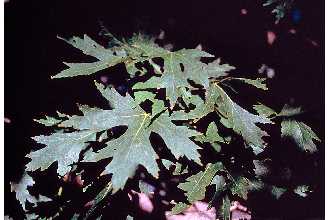
| General Information | |
|---|---|
| Usda Symbol | ACSA2 |
| Group | Dicot |
| Life Cycle | Perennial |
| Growth Habits | Tree |
| Native Locations | ACSA2 |
Plant Guide
Alternate Names
Soft maple, silverleaf maple, white maple, river maple, swamp maple, water maple
Uses
Silver maple has been heavily planted as an ornamental in many urban areas because of its ease of transplanting and establishment, adaptability to a wide range of sites, rapid growth, and good form. The species also has been used for vegetative rehabilitation of surface mined lands as well as for bottomland reforestation. Silver maple sap can be used to make a good, light syrup, although the sugar content of the sap is the lowest of the maple species used for syrup production. The sap has been used for kidney and liver ailments and also as a cough syrup. The wood of silver maple is fairly hard, even texture, rather brittle, and easily worked; it is used for furniture, cabinetry, paneling, flooring, woodturning, veneer, musical instruments, boxes and crates, tool handles, wagons, carts, and rails. Old heartwood develops a swirled pattern that is sold as “bird’s eye maple.” Silver maple on good sites can be managed for timber – it is often cut and sold with red maple as “soft maple” lumber. © William S. Justice Dept. of Botany, Smithsonian Institution @ PLANTS The abundant seeds of silver maples are eaten by many birds, including evening grosbeaks, finches, wild turkeys, ducks and other game birds, and small mammals, especially squirrels and chipmunks. The buds are an important food for squirrels when stored food is depleted, particularly in late winter and early spring. The bark is a food source for beavers and deer and rabbits browse the foliage. Silver maple tends to develop cavities that are used by cavity-nesting birds and mammals and provide shelter and breeding habitat for many other species, including raccoons, opossums, squirrels, owls, woodpeckers, and many other birds. Because of its abundance and wide distribution of silver maple, its early-produced pollen may be important to the biology of bees and other pollen-dependent insects. Most references describe red maple as wind pollinated, but insect pollination may be important, as many insects, especially bees, visit the flowers.
Status
Please consult the PLANTS Web site and your State Department of Natural Resources for this plant’s current status, such as, state noxious status and wetland indicator values.
Description
General: Maple Family (Aceraceae): A native tree reaching to mature heights of 27-36 m, usually with a short, thick trunk and spreading, open, irregular crown of long, curving branches with pendulous branchlets turning up at the ends; twigs with slightly unpleasant odour when crushed; bark gray and thin, becoming furrowed into long, shaggy, scaly ridges on older trunks and branches. The leaves are deciduous, opposite, 8-15 cm long and nearly as wide, long-petioled, deeply 5-lobed and long-pointed (middle lobe often 3-lobed) with V-shaped sinuses, doubly toothed, with three main veins from the base, dull green above, silvery-white beneath, usually turning pale yellow or soft gold in the autumn, occasionally scarlet and crimson (perhaps reflecting hybridization with red maple). The flowers are usually greenish or yellow from reddish buds, about 6 mm long, the male (staminate) flowers fascicled, the female (pistillate) flowers in drooping racemes, the flowers functionally male or female. Individual trees commonly have all male or all female flowers (the species essentially dioecious) or some trees may have more of one type than the other, and scattered flowers may be functionally bisexual (the species technically polygamo-dioecious). The fruits are winged nutlets (samaras) 4-6 cm long, light brown with pink veins, in a long-stalked, wide-spreading pair. The common name refers to the silvery appearance of the underside of the leaves. Variation within the species: Red maple forms natural hybrids with silver maple (A. saccharinum): Acer X freemanii E. Murray. The hybrids, however, are nearly sterile. Distribution: Silver maple grows over most of the eastern half of the United States and immediately adjacent Canada, except along major portions of the Gulf and Atlantic coastal plains. The natural range extends from Maine, New Brunswick, and southern Quebec, west to Minnesota and southeastern South Dakota, eastern Nebraska, Kansas, and Oklahoma, and south to Louisiana, Mississippi, Alabama, northwestern Florida, and central Georgia. It is relatively uncommon in the southern part of its range and absent at higher elevations in the Appalachians. Its abundance in natural habitats has decreased due to conversion of bottomland forests for agriculture but increased in urban areas due to planting. For current distribution, please consult the Plant Profile page for this species on the PLANTS Web site. Silver maple has been introduced to the western United States as an ornamental and to areas of the Black Sea coast of the Soviet Union and various parts of Europe.
Adaptation
Silver maple is found on stream banks, flood plains, and lake edges where it grows best on better-drained, moist alluvial soils, at elevations of 30-600 meters. Silver maple can grow on sites where soils are usually saturated most of the growing season. Seedlings have survived 60 days of continuously saturated soils. In the upper Mississippi River valley, silver maple trees survived 1 year of constant inundation (due to reservoir formation) but died after the second. It ranges from moderately shade-tolerant (good sites) to intolerant (poor sites). Silver maple dominance is usually in forest types that are pioneer to intermediate in succession and maintained only with management or disturbance, particularly flooding. It will quickly invade abandoned agricultural clearings and other cutover areas. Although it does not compete well with other species in upland sites, silver maple grows vigorously under a wide variety of conditions when planted as an ornamental. Silver maple flowers in (February)March-April(May), before the leaves, usually before red maple. All flowers on one tree are nearly synchronous. Fruiting occurs in April-June, maturing about 3 weeks after pollination and all released over a short period, usually less than 2 weeks.
Establishment
Silver maple may begin producing seed as early as 11 years old, Viable seed may be produced through self-pollination and large seed crops are produced annually, The seeds are primarily wind dispersed but are sometimes carried by water, Germination usually occurs in the spring shortly after dispersal – the seeds require no pretreatment or stratification (although seedlings require a considerable length of chilling to break dormancy), Natural regeneration by seed is most successful on moist mineral soil or moist litter, Seedling establishment requires full sun, but subsequent growth is best with partial shade, Use soil moisture sensors to measure the soil moisture of Silver Maple., Silver maple can be propagated from cuttings and bud grafts and by layering, Seeds are abundant but seedlings are highly variable, Sprouts from the stump or root crown are prolific, The best sprouting occurs from younger trees with stumps less than 30 cm in diameter, Flood energy breaks off aboveground portions of silver maple – the remaining stems sprout vigorously and may vary in number after such damage, Silver maples can live to 130 years or longer,
Management
Despite its usefulness in urban plantings, especially on poor sites, silver maple has significant limitations and is now not so commonly planted. It has been over-planted. It often grows to a larger size than anticipated and the brittle branches are easily broken in winter storms and wind storms. Pruning is often required to develop good form and to remove broken branches and old, multi-trunk trees often require cabling. Relatively soft wood renders silver maple susceptible to a number of wood rotting fungi and it is susceptible to various leaf molds and wilts (e.g., anthracnose, verticillium wilt, leaf spot, tar spot). Its large, vigorous, shallow-rooted root system can damage sidewalks and driveways, clog drain pipes, and penetrate septic systems and sewer pipes. Silver maple is susceptible to fire damage because of its thin bark, soft wood, and shallow/surface roots; surface fires kill seedlings and saplings and wound larger trees, exacerbating the tendency to rot. Prescribed fire is not recommended where silver maple is a desirable species. Silver maple can be managed on good sites for saw timber and on poor or wet sites for pulp or cordwood. Cultivars, Improved and Selected Materials (and area of origin) At least 58 cultivars have been named, encompassing variation in leaf form and color, branching pattern, and crown shape. At least one fruitless (male) strain has been selected.
References
Koelling, M.R. & R.B. Heiligmann (eds.) 1996. North American maple syrup producers manual. Ohio State Univ. Extension Bull. 856. AUG00. <http://www.ag.ohio-state.edu/~ohioline/b856/index.html> Li, H.-L. 1960. The cultivated maples. Morris Arbor. Bull. 11:41-47. Sullivan, J. 1994. Acer saccharinum. IN: W.C. Fischer (compiler). The fire effects information system [data base]. USDA, Forest Service, Intermountain Research Station, Intermountain Fire Sciences Laboratory, Missoula, Montana. Gabriel, W.J. 1990. Acer saccharinum L. Silver maple. Pp. 70-77, IN: R.M. Burns and B.H. Honkala (tech. coords.). Silvics of North America. Volume 2. Hardwoods. USDA, Forest Service Agric. Handbook 654, Washington, D.C.
Fact Sheet
Uses
Forest Buffers: Silver maple is a natural for use in riparian forest buffer installations due to its adaptation to such sites. However it should be used as a relatively minor percentage of the species mix because of its tendency to outgrow other species and mature at an early age. Where silver maple is already present in nearby stands, it should not be planted as it will show up in short order anyway. This species is much preferred to box elder in any planting. Wildlife: Silver maple is not notable for its attractiveness to wildlife, but as a source of fast shading, large woody debris, and litter in streams the species has few rivals. It seems to be a preferred nesting species for Baltimore orioles. Biofuels: The species is one of only a few that has the growth rate for serious consideration for biofuel production. Though shrub willow and poplar hybrids are currently receiving greater attention, silver maple has been tested for this use in the Midwest.
Status
Please consult the PLANTS Web site and your State Department of Natural Resources for this plant’s current status (e.g. threatened or endangered species, state noxious status, and wetland indicator values). © William S. Justice Smithsonian Institution @ USDA NRCS PLANTS
Description
Acer saccharinum L., silver maple is one of the fastest growing deciduous trees of the eastern and midwestern forests. Also called river maple, this name derives from the common occurrence of the species along our river systems. Silver maple shares many of its sites with red maple, but the two species are easily distinguished. Silver maple is typically a much larger tree with a much larger fruit (called a samara), but the two species are the only native maples with spring seed dispersal. The leaves of silver maple are often larger and more deeply fissured between lobes than those of red maple. Silver maple can grow 3-7 feet per year.
Adaptation and Distribution
Distribution
Distribution
Silver maple is adapted wherever adequate moisture is assured, but grows best on well drained but moist river bottom soils, It is rarely found at higher elevations in the uplands, The brittle nature of its wood limits the longevity of the species where high winds or heavy ice accumulations are common, As a pioneer species, silver maple is shade intolerant, Silver maple is distributed throughout most of the eastern United States, Use soil moisture sensors to measure the soil moisture of Silver Maple., For a current distribution map, please consult the Plant Profile page for this species on the PLANTS Website,
Establishment
Silver maple is among the easiest of trees to establish from seed or transplants. Its rapid growth competes well with other plants, although grass and weed control will improve survival and allow for even better growth. The seed germinates rapidly, and streambanks underneath mature trees are often covered with seedlings shortly after seed dispersal in the late spring, especially along the waterline. The rapid growth means that seedlings are almost always out-planted as 1-0 stock.
Management
In buffer plantings the only management needed is grass and weed control and livestock exclusion. Silver maple is not usually damaged by deer browsing, and is not a preferred target of gypsy moth caterpillars. On sites where natural regeneration produces too many saplings thinning should be carried out to allow other species to survive.
Plant Traits
Growth Requirements
| Temperature, Minimum (°F) | -47 |
|---|---|
| Adapted to Coarse Textured Soils | Yes |
| Adapted to Fine Textured Soils | Yes |
| Adapted to Medium Textured Soils | Yes |
| Anaerobic Tolerance | High |
| CaCO3 Tolerance | Medium |
| Cold Stratification Required | No |
| Drought Tolerance | Low |
| Fertility Requirement | Low |
| Fire Tolerance | Low |
| Frost Free Days, Minimum | 120 |
| Hedge Tolerance | None |
| Moisture Use | Medium |
| pH, Maximum | 7.3 |
| pH, Minimum | 4.0 |
| Planting Density per Acre, Maxim | 700 |
| Planting Density per Acre, Minim | 170 |
| Precipitation, Maximum | 70 |
| Precipitation, Minimum | 20 |
| Root Depth, Minimum (inches) | 32 |
| Salinity Tolerance | Low |
| Shade Tolerance | Intermediate |
Morphology/Physiology
| Bloat | None |
|---|---|
| Toxicity | None |
| Resprout Ability | Yes |
| Shape and Orientation | Rounded |
| Active Growth Period | Spring and Summer |
| C:N Ratio | High |
| Coppice Potential | Yes |
| Fall Conspicuous | Yes |
| Fire Resistant | No |
| Flower Color | Yellow |
| Flower Conspicuous | Yes |
| Foliage Color | Green |
| Foliage Porosity Summer | Dense |
| Foliage Porosity Winter | Porous |
| Foliage Texture | Medium |
| Fruit/Seed Conspicuous | Yes |
| Nitrogen Fixation | None |
| Low Growing Grass | No |
| Lifespan | Moderate |
| Leaf Retention | No |
| Known Allelopath | No |
| Height, Mature (feet) | 90.0 |
| Height at 20 Years, Maximum (fee | 45 |
| Growth Rate | Rapid |
| Growth Form | Single Stem |
| Fruit/Seed Color | Brown |
Reproduction
| Vegetative Spread Rate | None |
|---|---|
| Small Grain | No |
| Seedling Vigor | Low |
| Seed Spread Rate | Slow |
| Seed per Pound | 1610 |
| Fruit/Seed Persistence | No |
| Propagated by Tubers | No |
| Propagated by Sprigs | No |
| Propagated by Sod | No |
| Propagated by Seed | Yes |
| Propagated by Corm | No |
| Propagated by Cuttings | Yes |
| Bloom Period | Early Spring |
| Commercial Availability | Routinely Available |
| Fruit/Seed Abundance | High |
| Fruit/Seed Period Begin | Summer |
| Fruit/Seed Period End | Fall |
| Propagated by Bare Root | Yes |
| Propagated by Bulb | No |
| Propagated by Container | Yes |
Suitability/Use
| Veneer Product | Yes |
|---|---|
| Pulpwood Product | No |
| Protein Potential | Low |
| Post Product | No |
| Palatable Human | Yes |
| Palatable Graze Animal | Low |
| Palatable Browse Animal | Low |
| Nursery Stock Product | Yes |
| Naval Store Product | No |
| Lumber Product | Yes |
| Fuelwood Product | Medium |
| Fodder Product | No |
| Christmas Tree Product | No |
| Berry/Nut/Seed Product | No |

